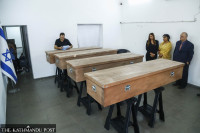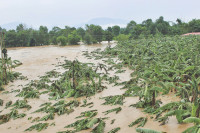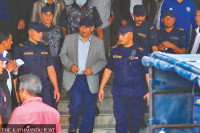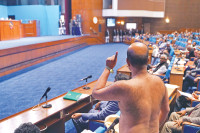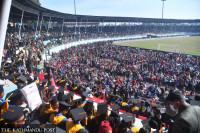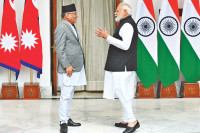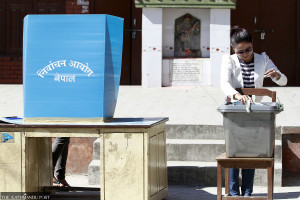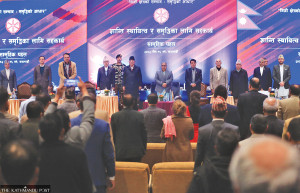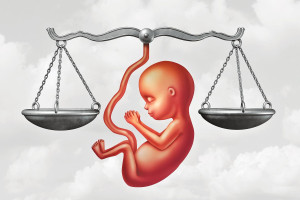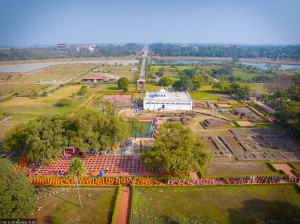Special Supplement
The Feminist Memory Project
The feminist movement of Nepal has a deep history but there has been no sustained effort to document the progresses and the struggles of the movement for in-depth study or public access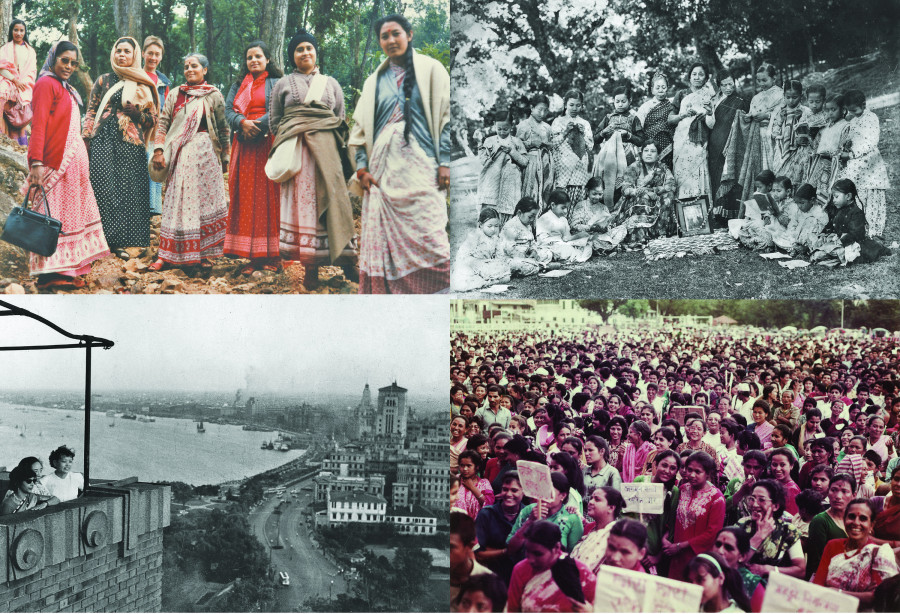
Nepal Picture Library
What is the Feminist Memory Project?
NayanTara: The feminist movement of Nepal has a deep history but there has been no sustained effort to document the progresses and the struggles of the movement for in-depth study or public access. We initiated The Feminist Memory Project in April 2018 with the intention of creating a visual archive within Nepal Picture Library of women’s and feminist movements in Nepal. Since then our team has been collating and digitising photographs relating to diverse aspects of Nepal’s feminist heritage, as well as other materials such as oral histories, testimonials, correspondences, pamphlets, and documents. Eventually, the goal is to be able to make all this available to scholars, researchers, curators, educators, and public users.

Diwas (left) and NayanTara (right)
Diwas: In some ways, the Feminist Memory Project is a result of two ongoing conversations. The first, in which the Nepal Picture Library has been engaged with since its very foundation, has to do with the question of inclusion. How do we free our histories—the narratives and images of our past—from the grips of economically and culturally dominant groups? How do we bring the diversities, dissensions and differences of our history into view? The Feminist Memory Project is a step towards that. The second agenda our project drew on concerned the dedicated work that feminist movements around the world have been putting in to create a distinct sphere of knowledge we now call women’s history. In Nepal, too, the need for women’s history is intensely felt, and we knew of many sporadic attempts to build chronicles and chronologies of a feminist past. Our hope with the Feminist Memory Project was that it would provide a formal nexus to connect these efforts.
What is the process? How big is the archive today?
NayanTara: We kickstarted the project by setting up a research team. Initially, we invited
several feminist and women’s rights activists for brainstorming, and we also made a public call for contributions. The work for the team has involved a great deal of learning, intense networking, convincing people about the value of their photographs and personal records. Today the Feminist Memory Project has around 8,000 high resolutions images in addition to oral history interviews, testimonials, correspondences, pamphlets, and other documents.
Diwas: In total, our research team met over 200 individuals who have directly given shape to the feminist landscape of Nepal or have been working to preserve the memory of past women. In the beginning, we were ourselves in need of reflecting on what recording and archiving visual materials means. So we even held an open seminar. The process has been about listening patiently to people’s accounts of themselves and others, and thinking about how these accounts can be brought out in the visual form. Sometimes we looked for narratives to be illustrated by photographs and other times we let narratives emerge from the photographs. The hardest part has been unearthing stories about more obscured women, especially as they also happen to belong to poorer and marginal communities. Their accounts don’t automatically come out in people’s ordinary memories as well, so we have had to go about this in a very concerted way. Tracing them in secondary literature whenever we could or finding alternative routes to discover them—by looking at peasant movements or labour movements, for instance.
Had you heard about Karjahi Movement before the project? Tell us something about the movement.
Diwas: During my Master’s work in Women’s History, I had done an oral history on underground communist women during the 1970s and 1980s. Many of those women—as cadres of the communist party—had become involved in politicising specific rural communities against the injustices of “samantabad” as it is popularly called. I had learned about the Karjahi case during that research, but I had also noticed that this case did not have the same kind of significance in the communist genealogy as other peasant revolts like in Piskar, Chhintang and Makwanpur did. The occasion of our project gave us a chance to reexamine this bit of history, and one of our researchers—Nisha Rai—did a tremendous work of travelling to Dang, tracking down individual women involved in the revolt and coming back with a preliminary oral history. One of the women who led the Karjahi movement, Patharkali Chaudhary, was called the “Indira Gandhi of Nepal” at the time. This revolt of the Tharu women had emerged forty years ago when the atrocities of local landlords and police against the farmers had peaked. Episodes like this rarely get incorporated into broader trajectories of Nepali history. The Feminist Memory Project hoped that by digging up bits of lost history like this and revitalizing them in public memory we could open up new possibilities of understanding and assessing the past.
How have your interpretations evolved over time?
NayanTara: Taking stock of the material that the Feminist Memory Project has archived so far, I am reminded that the champions of Nepali feminism are not limited to the articulate few whom we get the opportunity to read, or the few faces we see in the newspapers. The project has begun to visibilise hundreds of women across the political, economic and social spectrum, who have broken many boundaries and fought many brave fights—some of which they have won, and others which they continue to fight. The varied lives these women have lived, has made me think about how different women have chosen to engage with feminism in different ways—through words or political mobilization or education or grassroots actions or the arts. The project has collated valuable material thus far, but has also identified an immense list of yet to be burrowed sources in intersections, margins and less accessible pockets of women’s experiences. All this indicates to great research potentials. Archives are after all repositories of knowledge, but also point to everything that surrounds this knowledge that it does not hold. Moving forward, I am keen to further our work by launching new inquiries to archive, take stock of, discuss, debate and learn from all our contributors. Through these processes, the hope is that we create space for intergenerational conversations and learnings as we recollect, share and carry forth lessons that will hopefully shape and strengthen the future of Nepali feminism.
NayanTara Gurung Kakshapati is the co-founder and director of photo.circle, Nepal Picture Library and Photo Kathmandu. She enjoys working across platforms to connect visuals, research, pedagogy, and collective action.
Diwas Raja Kc is an independent researcher, writer, and curator based in Kathmandu. At Nepal Picture Library, he previously led research for the creation of its Dalit archive. He also works as a documentary film editor.

Kathmandu | 1981
Women from all walks of life gather for a mass meeting in Kathmandu to submit a letter of protest to the government following the rape and murder of sisters Namita and Sunita Bhandari in
Pokhara that rocked the country.Hisila Yami Collection/Nepal Picture Library

Rolpa | 1998
Journalist Amrita Lamsal and friend Gyanu Pandey trekking in Rolpa to cover the incipient Maoist Insurgency. Amrita Lamsal Collection/Nepal Picture Library

Kathmandu | 1979
Annapurna Kunwar performs parajumping over Chobar, becoming the first Nepali woman to do so. She had heard a soldier brag about his parajumping feats at the Army Hospital where she
worked as a nurse, which stayed on her mind. When an ex-Army chief promised her a favour after being impressed with her nursing work, she asked to be allowed to do this. Annapurna
Kunwar Collection/Nepal Picture Library

Makwanpur | 1956
A working crew of predominantly women dig up the Tribhuvan Highway, Nepal's first motorable highway linking Kathmandu to Raxaul, India. Meena Acharya Collection/Nepal Picture Library

Kathmandu | c.1935
Chandra Kanta Devi Malla, known as the first “guruama” of Nepal, with other instructors and students. At a time when public education was seen by the ruling elites as perilous and
women’s schools were unheard of, Chandra Kanta managed to convince the Rana government against the odds to let her open a girls’ school in Makhantole.Chandra Kanta Devi Malla
Collection/Nepal Picture Library

When Sahana Pradhan returned with her family to Kathmandu from Burma at age 13, her schooling was suddenly stopped and her movement controlled. She could not tolerate it. The desire to continue her education led her to join the struggle to end Rana oligarchy of the time. After her first arrest for attending political protest in 1947, she was one of the protesters who was granted an audience with Prime Minister Padma Shamsher Jang Bahadur Rana. She used the chance to demand the opening of Durbar High School to women. When he replied he would think about it, Pradhan boldly retorted, “We need to know by when.” He replied, "Within two weeks.” And surprisingly Padma Kanya School was established as a woman’s wing within weeks of that encounter. The following year, she became one of the first four women to clear their SLC exams.

Kathmandu | 1961
Prem Kumari Tamang of Nuwakot and Lal Maya Tamang of Dhading put in Dillibazar Prison for their opposition of King Mahendra’s coup d’état. Shanta Shrestha Collection/Nepal Picture Library

Photograph of one of the Tharu women from Karjahi, Dang who led a peasants’ revolt against the abuses of local landlords in 1980. The landlords had started intimidating peasants and vandalising their property with police help following the national land tenure reform of 1979, compelling these women to take action.
Karjahi Movement Collection/Nepal Picture Library

Kathmandu | 1980
Mangala Devi Singh addresses a crowd after Nepal Women’s Association, along with Nepali Congress Party, resurfaced from hiding for the 1980 referendum between a non-partisan Panchayat system and a multi-party system.

Known as “Mechiki Didi”, Saraswati Rai campaigned for girls’ education in Ilam through the 1950s. She had fielded her name for the 1959 election but was told by the male leaders of the Congress Party that the timing was not right. The following year she started her long career as Ilam’s district president of the Panchayat’s women’s organisation. During her tenure, she traveled widely across the country to promote women’s literacy and raise awareness about social discriminations. Saraswati Rai Collection/Nepal Picture Library

Doti | 1964
Gomati Shrestha, who always excelled in her classes, holds tuition for children at her home. Gomati Shrestha Collection/Nepal Picture Library

Shanghai, China | 1963
Shashikala Sharma stops by Shanghai during an international tour that covered the Soviet Union, China, Burma, and East Pakistan. Shashikala Sharma Collection/Nepal Picture Library

Nawalparasi | 1986
A group of women training to be officers for Women Development Division on their way to Rajahar, Nawalparasi. Prativa Subedi Collection /Nepal Picture Library

Biratnagar | 2004
Women workers at a jute textile factory in Biratnagar. GEFONT Collection/Nepal Picture Library




 16.09°C Kathmandu
16.09°C Kathmandu
